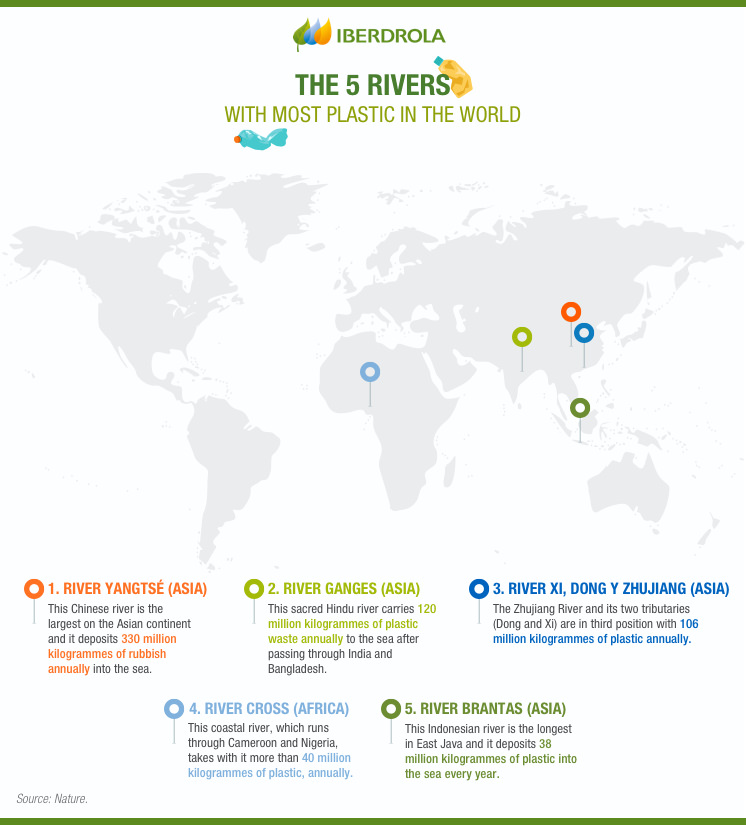How does plastic get into the sea?
Where does the plastic come from that inundates our oceans?
Plastic is overwhelming our oceans and it's causing incalculable environmental damage. This situation raises many questions: How does plastic get into the ocean? Where does the waste come from? What can we do to avoid it? We outline below the main factors responsible.

Plastics are the most-collected waste by the NGO Ocean Conservancy in their annual clean-up visits to beaches and coastal areas. Since 1986, it has mobilised thousands of volunteers worldwide and according to the report The Beach and Beyond 2019, which sums up their activities in the Top 10 rubbish items recognising that for the first time in 30 years the top 10 most-commonly found items found in clean-ups are all plastic objects such as cigarette butts, packaging and disposable straws, among others, and these take 500 years to decompose.
How and why does plastic end up in the ocean?
Pollution and plastic in the ocean almost always starts with our rubbish bins. According to a report by consultants McKinsey & Company, of the 260 million tonnes of plastic worldwide that we throw away on a yearly basis, only 12% gets recycled, while the vast majority gets incinerated, thrown into landfill, or ends up in the most unlikely corners of the planet, such as the Challenger chasm on the seabed.
Most of this abandoned waste ends up in the ocean, where waves and wind break it down into tiny fragments known as microplastics. These less than 5 mm particles get sucked into ocean whirlpools forming huge floating islands of plastic such as the Great Pacific Garbage Patch, the largest in the world measuring 1.6 million km2 and weighing 80,000 tonnes.
If these polymers are discarded thousands of miles away, how do they end up floating in the oceans? The New Zealand oceanographer Laurent Lebreton suggests in his research published in scientific journal Nature, in 2017 and 2019, that rivers, especially the largest and most polluted ones, are the main factors responsible for plastic being carried to the seas — according to his estimate, between 1.1 and 2.4 million tonnes every year —.
Lebreton also includes people's behaviour on the beaches, as well as fishing practices, farming and maritime transport as among other causes responsible for plastic in the sea. Unsurprisingly, waste originating from boats is responsible for almost half of the pollution found to date in the North Pacific Garbage Patch, as shown in a recent study published by Nature magazine. Wastewater, wind, rain and floods also carry plastic from the land into the oceans, especially single-use plastics — bags, straws, cotton buds or wrappers — which, being lightweight, are easily carried on the wind to the coast or find their way to the river network before reaching the sea.
The five rivers with most plastic in the world


How much plastic goes into the sea?
The United Nations Environment Program (UNEP) warns that the oceans receive about 13 million tonnes of plastic each year, the equivalent of tipping one dustbin lorry into the ocean every minute. This amount could grow to 17.5 million tonnes per year by 2025 if we don't stop dumping it, according to Jenna R. Jambeck, researcher at the University of Georgia and one of the world's leading experts in oceanic plastic pollution.
The World Economic Forum (WEF) goes further and predicts that, at this rate by 2050 we could have more tonnes of plastic in the oceans than fish. Most of the plastic pollution in the sea comes from Asia, in particular from countries such as China, Indonesia, the Philippines and Vietnam, the first four on a list drawn up by the Jambeck team.
Consequences of plastic in the ocean and ways to avoid it
Today, indirect damage from marine pollution is well-known worldwide: ecosystem degradation, exposure of flora and fauna to chemical substances — more than one million animals die each year due to mistaking plastic for food —. Additionally, our health may also suffer from this polymer, because we ingest it in table salt and other foods. The UNEP estimates that the cost of this ecological catastrophe is about $13 billion annually, which we could reduce with everyday habits as simple as these:
Avoid single-use plastics, such as straws, plates or disposable cutlery.
If you go shopping, remember to take a fabric bag-for-life or a shopping trolley.
Don't throw chewing gum on the ground, bin it because... it's also made of plastic!
Buy more food in bulk and fewer packaged products.
Replace plastic Tupperware with glass or stainless steel containers.
When hanging out washing use wooden pegs instead of plastic ones.
Avoid using cosmetics with microplastics and also opt for biodegradable clothing.
Choose to recycle and reuse some of your packaging too.




